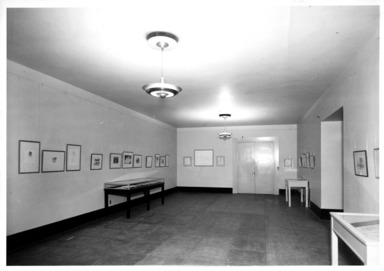
Recent Accessions: Prints
DATES June 01, 1936 through 1936 (date unknown)
-
June 12, 1936
The French section of the Brooklyn Museum Print Department has been strengthened and enlivened by important recent accessions; the exhibition of prints newly acquired, which opened today (Friday, June 12), makes this clear. Pierre Bonnard (1867–), Felix Bracquemond (1833–1914), Paul Cezanne (1839–1906), Honore Daumier (1808–1879), Edgar Degas (1834–1917), Andre Derain (1880–), Jean Louis Forain (1852–1931), Alphonse Legros (1837–1911), Edouard Manet (1832–1883), Henri Matisse (1864–), Georges Rouault (1871–), Paul Signac (1863–), and Henri de Toulouse-Lautrec (1864-1901) are the French artists represented by the current exhibition. A drawing by Jean Francois Millet (1814–1875) is also included.
Among other items shown are an Abstraction from a "Portfolio of Ten Blockprints" by Werner Drowes, prominent young American abstract painter and print-maker; "Jean le Musicien" a large decorative head in lithograph by Juan Gris (1887-1927), Spanish School; two Street Scenes from "Paysages Urbains," a portfolio of expressionist prints by Stanley William Hayter (1901-), English School; several items by Pablo Picasso, his "Groupe de Tois Femmes Nues," line etching, being one of the most sheerly beautiful prints in the exhibition; "The Poet" by Giuseppe Ribera (Lo Spagnoletto) (1590–1352), Spanish School; "Zapata" by Diego Rivera (1886–), Mexican School, and two etchings by Giovanni Battista Tiepolo (1696–1770) from the series "Scherzi di Fantasia," acquisition of which has been previously announced. Both the Bonnard prints are lithographs in color, one a very lively sunlit scene of a market, chiefly in pink and yellow, but with three accents of black masses. "Les Saules de Mottiaux" by Bracquemond is an extremely pretty and romantic landscape but handled with great clarity and light in a pattern of free open lines that keeps the more or less typical subject from the banal. The Cézanne is a quick sketch (etched) of the painter "Armald Guillaumin,” a nervous characteristic drawing. The Daumiers are clear and fine, one the “Madeleine Bastille" an amusing comic episode of the entrance of a fat woman in a railway carriage, one a full length satirical portrait of a French politician “Charles Guillaume Etienne,’ the third a group of fifteen grotesque Masques of 1831.
"Apres le Bain" (lithograph), "Au Louvre, Musee des Antiques" (aquatint), and "Au Louvre, La Peinture (Mary Cassatt)" (etching and aquatint), by Degas are all studies of groups of figures, the last two being variations on the same theme of composition. Their strength, breadth and rich darkness surprise in contrast with the lightness and delicacy of his more familiar work. "Danseuse Mettant son Chausson" is a hasty line sketch in etching. Three of these prints are from the artists collection.
The abstractions by Werner Drewes satisfy by really decorative add evocative composition and by richness of detail. They remain purely abstract. But the expressionistic performances by Hayter will take more explaining and justification. Each features a somewhat distorted landscape superimposed upon a sketch of something entirely unrelated, for instance a vase of flowers, a reclining nude. The two are connected by placing in composition and usually the connection is emphasized by otherwise meaningless caligraphic lines. If one disregards this trick, the landscapes please by light, clarity and decisive line.
Brooklyn Museum Archives. Records of the Department of Public Information. Press releases, 1931 - 1936. 04-06_1936, 073-4.
View Original